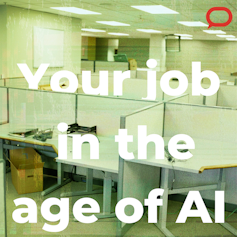It’s the defining technology of an era. But just how artificial intelligence (AI) will end up shaping our future remains a controversial question.
For techno-optimists, who see the technology improving our lives, it heralds a future of material abundance.
That outcome is far from guaranteed. But even if AI’s technical promise is realised – and with it, once intractable problems are solved – how will that abundance be used?
We can already see this tension on a smaller scale in Australia’s food economy. According to the Australian government, we collectively waste around 7.6 million tonnes of food a year. That’s about 312 kilograms per person.
At the same time, as many as one in eight Australians are food-insecure, mostly because they do not have enough money to pay for the food they need.
What does that say about our ability to fairly distribute the promised abundance from the AI revolution?
AI could break our economic model
As economist Lionel Robbins articulated when he was establishing the foundations of modern market economics, economics is the study of a relationship between ends (what we want) and scarce means (what we have) which have alternative uses.
Markets are understood to work by rationing scarce resources towards endless wants. Scarcity affects prices – what people are willing to pay for goods and services. And the need to pay for life’s necessities requires (most of) us to work to earn money and produce more goods and services.
This article is part of The Conversation’s series on jobs in the age of AI. Leading experts examine what AI means for workers at different career stages, how AI is reshaping our economy – and what you can do to prepare.
The promise of AI bringing abundance and solving complex medical, engineering and social problems sits uncomfortably against this market logic.
It is also directly connected to concerns that technology will make millions of workers redundant. And without paid work, how do people earn money or markets function?
Meeting our wants and needs
It is not only technology, though, that causes unemployment. A relatively unique feature of market economies is their ability to produce mass want, through unemployment or low wages, amid apparent plenty.
As economist John Maynard Keynes revealed, recessions and depressions can be the result of the market system itself, leaving many in poverty even as raw materials, factories and workers lay idle.
In Australia, our most recent experience of economic downturn wasn’t caused by a market failure. It stemmed from the public health crisis of the pandemic. Yet it still revealed a potential solution to the economic challenge of technology-fuelled abundance.
Changes to government benefits – to increase payments, remove activity tests and ease means-testing – radically reduced poverty and food insecurity, even as the productive capacity of the economy declined.
Similar policies were enacted globally, with cash payments introduced in more than 200 countries. This experience of the pandemic reinforced growing calls to combine technological advances with a “universal basic income”.
This is a research focus of the Australian Basic Income Lab, a collaboration between Macquarie University, the University of Sydney and the Australian National University.
If everyone had a guaranteed income high enough to cover necessities, then market economies might be able to manage the transition, and the promises of technology might be broadly shared.

Jools Magools/Pexels
Welfare, or rightful share?
When we talk about universal basic income, we have to be clear about what we mean. Some versions of the idea would still leave huge wealth inequalities.
My Australian Basic Income Lab colleague, Elise Klein, along with Stanford Professor James Ferguson, have called instead for a universal basic income designed not as welfare, but as a “rightful share”.
They argue the wealth created through technological advances and social cooperation is the collective work of humanity and should be enjoyed equally by all, as a basic human right. Just as we think of a country’s natural resources as the collective property of its people.
These debates over universal basic income are much older than the current questions raised by AI. A similar upsurge of interest in the concept occurred in early 20th-century Britain, when industrialisation and automation boosted growth without abolishing poverty, instead threatening jobs.
Even earlier, Luddites sought to smash new machines used to drive down wages. Market competition might produce incentives to innovate, but it also spreads the risks and rewards of technological change very unevenly.
Universal basic services
Rather than resisting AI, another solution is to change the social and economic system that distributes its gains. UK author Aaron Bastani offers a radical vision of “fully automated luxury communism”.
He welcomes technological advances, believing this should allow more leisure alongside rising living standards. It is a radical version of the more modest ambitions outlined by the Labor government’s new favourite book – Abundance.
Bastani’s preferred solution is not a universal basic income. Rather, he favours universal basic services.

Ersin Basturk/Pexels
Instead of giving people money to buy what they need, why not provide necessities directly – as free health, care, transport, education, energy and so on?
Of course, this would mean changing how AI and other technologies are applied – effectively socialising their use to ensure they meet collective needs.
No guarantee of utopia
Proposals for universal basic income or services highlight that, even on optimistic readings, by itself AI is unlikely to bring about utopia.
Instead, as Peter Frase outlines, the combination of technological advance and ecological collapse can create very different futures, not only in how much we collectively can produce, but in how we politically determine who gets what and on what terms.
The enormous power of tech companies run by billionaires may suggest something closer to what former Greek finance minister Yanis Varoufakis calls “technofeudalism”, where control of technology and online platforms replaces markets and democracy with a new authoritarianism.
Waiting for a technological “nirvana” misses the real possibilities of today. We already have enough food for everyone. We already know how to end poverty. We don’t need AI to tell us.





![[Photo = Yonhap News]](https://aistoriz.com/wp-content/uploads/2025/08/news-p.v1.20250831.e738e78a131544a38de88cd64aaced2a_P1.jpg)


















